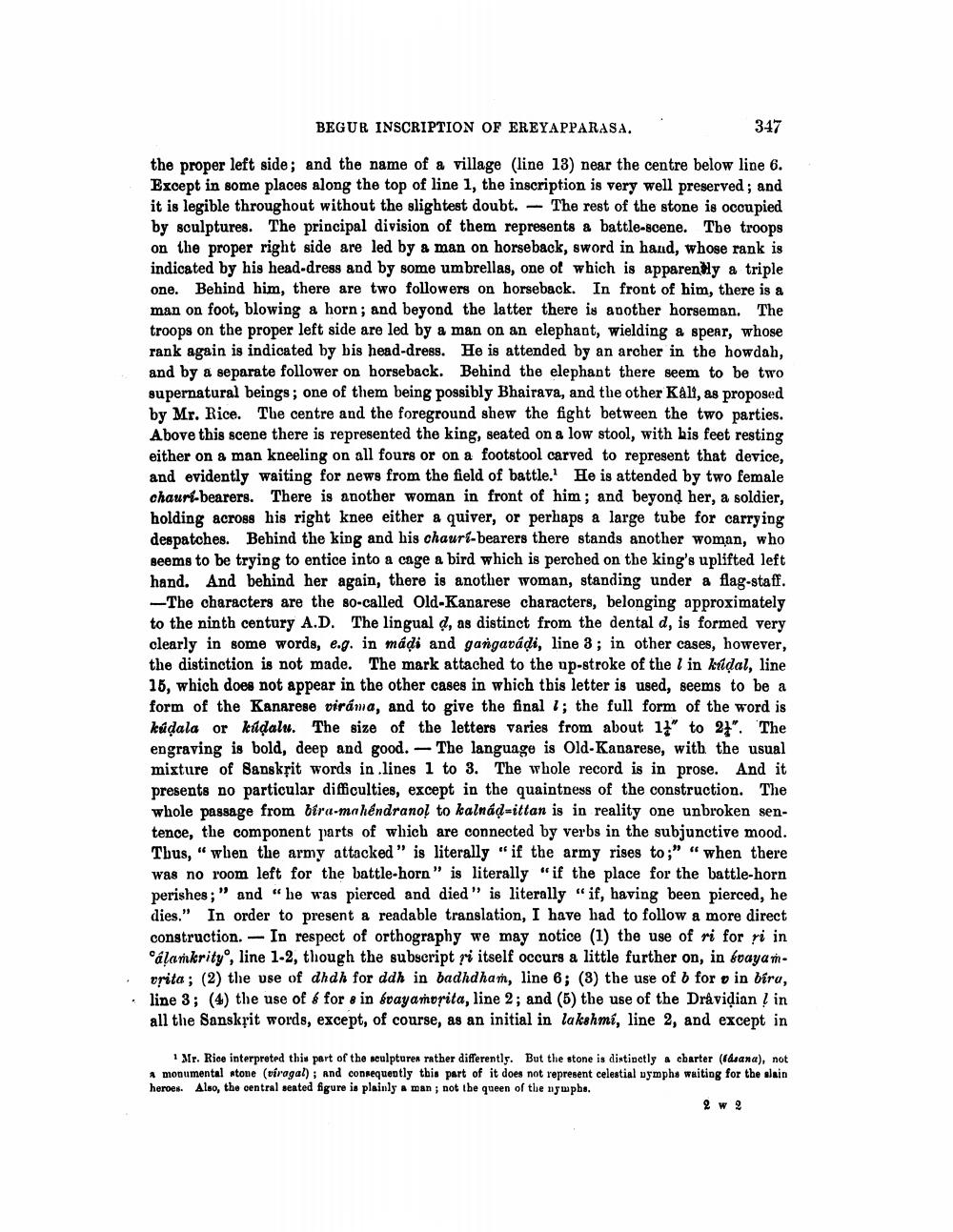________________
BEGUR INSCRIPTION OF EREYAPPARASA.
347
the proper left side; and the name of a village (line 13) near the centre below line 6. Except in some places along the top of line 1, the inscription is very well preserved; and it is legible throughout without the slightest doubt. - The rest of the stone is occupied by sculptures. The principal division of them represents a battle-scene. The troops on the proper right side are led by a man on horseback, sword in hand, whose rank is indicated by his head-dress and by some umbrellas, one of which is apparently a triple one. Behind him, there are two followers on horseback. In front of him, there is a man on foot, blowing a horn; and beyond the latter there is another horseman. The troops on the proper left side are led by a man on an elephant, wielding a spear, whose rank again is indicated by bis head-dress. He is attended by an archer in the howdah, and by a separate follower on horseback. Behind the elephant there seem to be two supernatural beings; one of them being possibly Bhairava, and the other Kal1, as proposed by Mr. Rice. The centre and the foreground shew the fight between the two parties. Above this scene there is represented the king, seated on a low stool, with his feet resting either on a man kneeling on all fours or on a footstool carved to represent that device, and evidently waiting for news from the field of battle. He is attended by two female chauri-bearers. There is another woman in front of him; and beyond her, a soldier, holding across his right knee either a quiver, or perhaps a large tube for carrying despatches. Behind the king and his chaurt-bearers there stands another woman, who seems to be trying to entice into a cage a bird which is perched on the king's uplifted left hand. And behind her again, there is another woman, standing under a flag-staff. -The characters are the so-called Old-Kanarese characters, belonging approximately to the ninth century A.D. The lingual d, as distinct from the dental d, is formed very clearly in some words, e.g. in madi and gangavadi, line 3; in other cases, however, the distinction is not made. The mark attached to the up-stroke of the l in kiidal, line 16, which does not appear in the other cases in which this letter is used, seems to be a form of the Kanarese viráma, and to give the final l; the full form of the word is kádala or kudalu. The size of the letters varies from about 11" to 21". The engraving is bold, deep and good. - The language is Old-Kanarese, with the usual mixture of Sanskrit words in lines 1 to 3. The whole record is in prose. And it presents no particular difficulties, except in the quaintness of the construction. The whole passage from bira-mahendranol to kalnád=ittan is in reality one unbroken sentence, the component parts of which are connected by verbs in the subjunctive mood. Tbus," when the army attacked" is literally "if the army rises to;" " when there was no room left for the battle-horn" is literally "if the place for the battle-horn perishes;" and "he was pierced and died" is literally "if, having been pierced, he dies." In order to present a readable translation, I have had to follow a more direct construction. - In respect of orthography we may notice (1) the use of ri for ri in alankrity", line 1-2, though the subscript ri itself occurs a little further on, in bayanvrita; (2) the use of dhdh for ddh in badhdham, line 6; (3) the use of b for o in biru, line 3; (4) the use of 6 for ein Svayamorita, line 2; and (5) the use of the Dravidian ļ in all the Sanskrit words, except, of course, as an initial in lakshmi, line 2, and except in
1 Mr. Rice interpreted this part of the sculptures rather differently. But the stone is distinctly a charter ((asana), not * monumental stone (viragal); and consequently this part of it does not represent celestial vymphs waiting for the slain heroes. Also, the central seated figure is plainly a man; not the queen of the nymphs.
2 w 2




